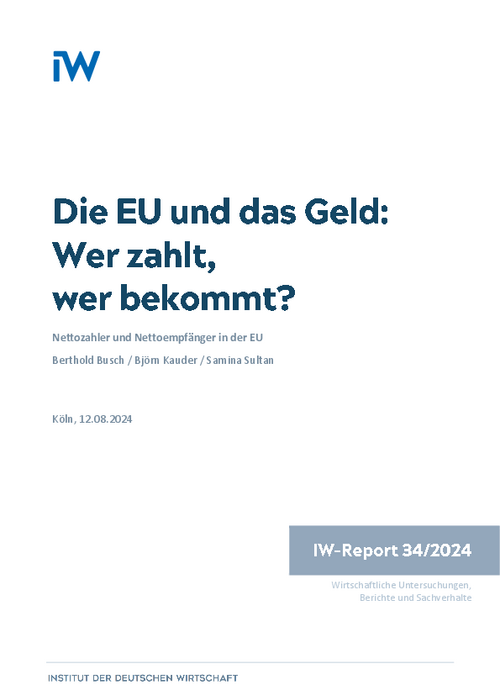The German net position fell slightly in 2023 compared to the previous year, from 19.7 billion euros to 17.4 billion euros. However, it is still significantly higher than in the pre-Brexit period.

The EU and money: Who pays, who gets?

The German net position fell slightly in 2023 compared to the previous year, from 19.7 billion euros to 17.4 billion euros. However, it is still significantly higher than in the pre-Brexit period.
The average for the years 2014 to 2020, the last Multiannual Financial Framework (MFF), was 13.5 billion euros. Germany is therefore still the largest net contributor in the European Union (EU), ahead of France, which last year paid out almost 9 billion euros more than it received back. Italy is in third place with a net contribution of 4.5 billion euros. As in the previous year, the largest net recipient is Poland with 8.2 billion euros (2022: 11.9 billion euros). Romania and Hungary are some way behind with 6 billion euros and 4.6 billion euros, respectively.
Surprisingly, in terms of net payments per capita, Ireland leads the way this year with 236 euros per capita, some way ahead of Germany (206 euros per capita). In relation to gross national income (GNI), however, Germany remains the largest net contributor. Per capita and as a percentage of GNI, as in previous years, the Baltic states in particular can benefit from the financial relationship with the EU budget.
The breakdown of the total net position into partial balances shows which member states benefit most financially from agricultural and cohesion policy. According to this calculation, the largest net beneficiary of agricultural policy is Greece with 1.05 percent of GNI. Other major net recipients of the EU agricultural budget are Bulgaria and Lithuania. Latvia and Hungary are the fourth and fifth largest net recipients from the agricultural budget.
The largest net recipient of cohesion spending is Croatia with 2.45 percent of GNI. Slovakia is in second place with 2.06 percent of GNI. Hungary is again among the top 5 net recipients, with 1.77 percent of GNI, followed by Latvia (1.76 percent) and Bulgaria (1.39 percent). Overall, spending on cohesion policy fell for the second time in a row in 2023. This can be explained by the structure of the EU's cohesion policy, in which payments are delayed at the beginning of the current MFF, while payments from the previous MFF gradually cease.
The analysis is extended to include the financial flows within the framework of NextGeneration EU, as this is a significant secondary budget that is also financed by an unprecedented level of borrowing by the European Union. The largest net recipient from the NGEU fund in 2023 is Greece with 1.31 percent of GNI, followed by Portugal and Croatia with 1.21 percent of GNI each.

The EU and money: Who pays, who gets?

More on the topic
![[Translate to English:] Das Gebäude des Weißen Hauses in Washington, D.C. in den Vereinigten Staaten von Amerika. [Translate to English:] Das Gebäude des Weißen Hauses in Washington, D.C. in den Vereinigten Staaten von Amerika.](/fileadmin/_processed_/c/1/csm_GettyImages-2161499385_White_House_Editorial_884306add8.jpg)
Trump or Harris or ...? What Europe must prepare for
A few months before the presidential election in the USA, Donald Trump has a good chance of being re-elected. On the Democratic side, the incumbent president has withdrawn his candidacy after a long period of hesitation, while Vice President Kamala Harris is ...
IW
Compendium 5.5: CO2 Regulation of Road Transport in Europe
With the Compendium CO2 Regulation in Europe, the IW has been providing the interested public with a comprehensive collection of data on the development of CO2 emissions from passenger car traffic in the European Union, as well as on the applicable regulatory ...
IW